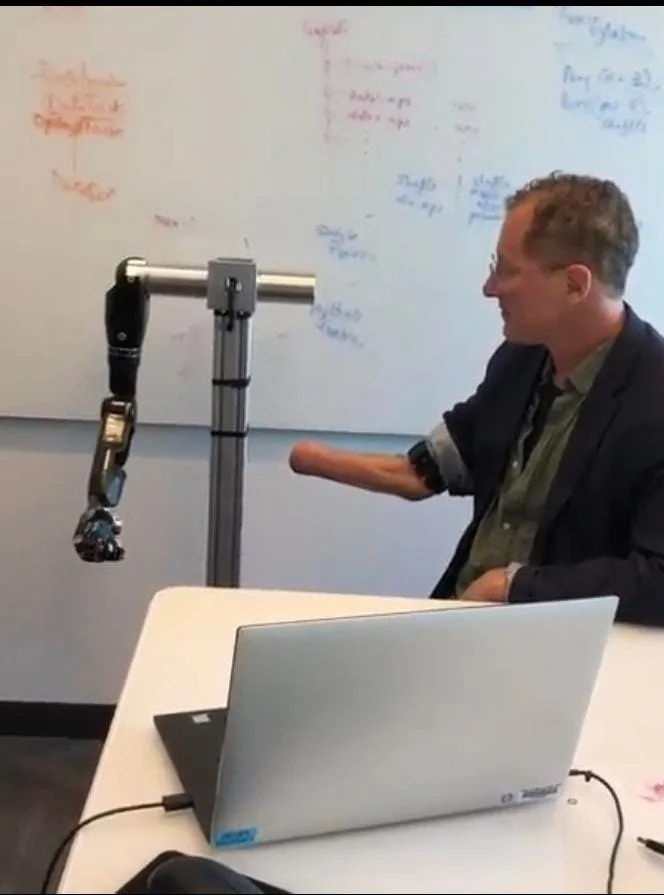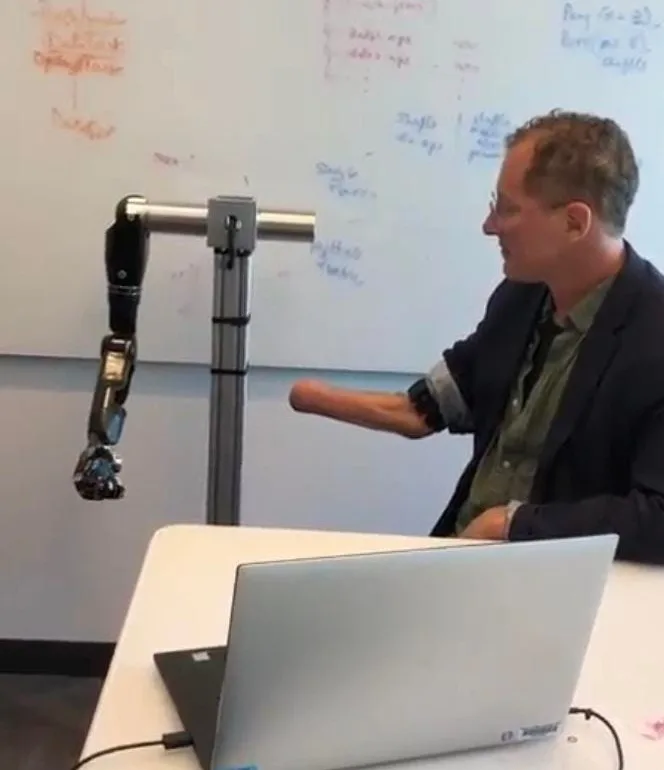
When we have a problem, we create a solution. Sounds easy, right? Consider restoring mobility to a person who is missing a hand by allowing them to control a robotic hand. Elon Musk’s Neurolink aims to solve this problem by embedding a microchip into our brains. Through machine learning, this microchip will learn and decode our brainwaves and transmit the action directly to a robotic hand. It’s complex, risky (this is brain surgery), expensive, and several years away. Now, consider what a group of scientists and medical professionals did in this photo.
Recognizing the moving a hand triggers a process within the body, they used an IoT sensor array just above the elbow to track muscle, tendon, and ligament motion. An AI system has decoded what these movements mean and triggers the robotic arm to move accordingly. It’s simpler, non-invasive, cheaper, and already here. Same problem, but two different solutions.
How we approach a problem is critical to developing an effective solution. This is one of the biggest challenges that many companies face when trying to implement diversity and inclusion (D&I), especially at the corporate boardroom level. One of the biggest struggles for organizations is how they recruit board candidates. “There needs to be a paradigm shift on how they’re approaching the problem,” states David Chun, CEO of Equilar, a board solutions platform. The traditional approaches of the Old Boy Network or seeking C-suite executives at other companies has created the perception that there is a supply problem. Chung shares, “Boards are often relying on recruiters who bring in a small subset of the available talent. If they don’t show enough good candidates, boards believe there’s isn’t much supply.”
So, how do we overcome this challenge? Innovators like Chung are finding different approaches by tapping into the power of technology and process.
The LinkedIn for Corporate Boards
Equilar is focused on broadening the pool of board candidates, particularly diverse candidates. Chung describes Equilar as, “a LinkedIn for the Board world,” that concentrates on helping frustrated companies that are trying to find D&I candidates. Leveraging technology, Equilar’s platform captures data from public sources (SEC filings, corporate websites, etc.) and builds and maintains corporate leadership profiles to take advantage of network externalities. Prospective and existing board candidates can enhance their profiles and use the platform to document their experiences and network connections. By doing this, Equilar has created a giant, detailed database for companies to tap into for board recruitment. In essence, they’ve expanded the pool of candidates. How effective is Chung’s company? Well, NASDAQ has adopted Equilar to help advance diversity, especially for compliance to it’s new listing requirements.
Robot And Human Hand Joining Red And Blue Jigsaw Over The Blue Digital Background
Teaching “How to Fish”
Most people do not fully understand what a Board of Director does. In fact, most Board members are not even aware when they take their first Board role. Given this, it is not surprising that companies tend to struggle in recruiting new D&I candidates and aspiring Directors are floundering in how to get ready for these opportunities. We have so many educational programs to help up-skill people or learn new capabilities. Why don’t we have one for corporate Boards? Actually, we do.
Debbie McCormack is the Managing Direct at Deloitte’s Center for Board Effectiveness. Originally, McCormack was focused on energy programs with a board luncheon focused on current topics like cybersecurity. However, given the popularity and growth, this led McCormack into Deloitte’s Center for Board Effectiveness where she has helped roll out a series of training programs and events. “We assist in facilitating networking opportunities and to help get future candidates be Board ready,” shares McCormack. To help prepare future candidates, Deloitte has launched programs in over twenty-five major markets. This has helped clarify some of the key responsibilities for prospective Board members. “The most important job of the board is to make sure they have the right CEO, with the right strategy, and holding management’s feet to the fire around that strategy,” explains McCormack.
While Deloitte’s program is helping to expand the pool of candidates, there’s still the matter for the companies and their Boards actively finding diverse candidates. Deloitte is hitting them with corporate performance. Based on extensive research, McCormack points out some of the key benefits Deloitte has found from organizations having diverse boards and an inclusive culture:
· Twice as likely to meet their financial goals
· There three times as likely to be high performing
· Eight times more likely to have better business outcomes
It’s bench marked. Corporations with boards that have solid D&I representation perform better. For many organizations, there is a strong commitment for diversity. So, why is traction so slow? As Chung indicated, one big reason is the board perception of small supply. In her work with Boards, McCormack has observed this, “many Boards work with search firms, but to get a diverse set of candidates, it is important to look beyond traditional CEO candidates, expand the population.” That’s why groups like Deloitte’s Center for Board Effectiveness are also working with the C-suite and existing Boards to expand out. “Boards should look to expand their network they need to go to people who don’t look like them who aren’t on their board,” McCormack advocates.
It’s a match maker process. We have to get the future Board candidates ready with the right advocates and visibility. On the flip side, we must get companies to think beyond their traditional approaches to break the fallacy of small pools of talented, diverse candidates.
This is a lot of work, but thankfully, we’ve just scratched the surface on solutions to drive sustained change. Initiatives like the Time Capsule Project focus on addressing these challenges and ensuring a sustained pipeline of candidates. Founder Barry Williams has advocated for better board rotation, term limits, and larger boards. He has also developed a program to provide a pool of talented African American candidates. Moreover, he is taking solutions one step further by finding ways to put pressure on businesses to make changes in areas of compensation, process, and search requirements. And this will take us to the next set of solutions we’ll need to enact true, permanent change.
This article is part 4 in this series on diversity and inclusion in corporate Board of Directors. Our next article will focus on the solutions we can make within the structure of the Boards and corporate leadership.



